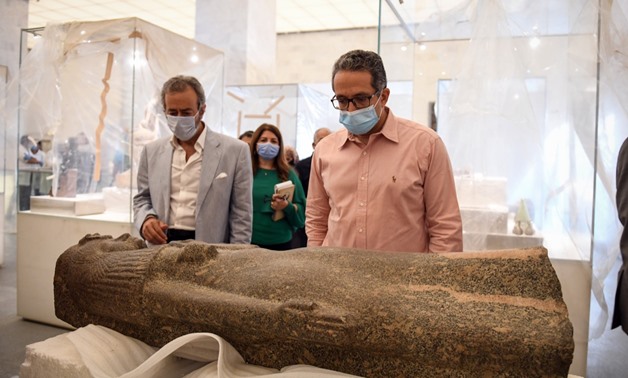
Anani during the inspecting tour in NMEC - ET
CAIRO - 10 June 2020: Egypt’s Minister of Tourism & Antiquities Khaled el-Anani inspected the latest developments in the central exhibition hall of the National Museum of Egyptian Civilization in Fustat prior to its opening.
Anani was accompanied by Secretary General of the Supreme Council of Antiquities Mostafa Waziri, General Supervisor of the Museum Ahmed el-Sherbiny, Minister's Advisor for Museum Display Mahmoud Mabrouk and members of the Higher Committee for Museum Display headed by Ali Omar.
The tour started by checking the operation of electronic portals for entrance and exit, placing artifacts inside the exhibition hall and checking the preparations for receiving the royal mummies from the Egyptian Museum in Tahrir in a royal procession.
Anani instructed some adjustments to the exhibiting scenario to contribute to highlighting the exhibited items.
After completing the tour, the minister of tourism and antiquities met the museum's archaeologists and restorers, in addition to members of the Supreme Committee of the museum's exhibiting scenario.
During the meeting, the ongoing preparations for receiving the royal mummies from the Egyptian Museum in Tahrir in a huge royal procession and the method of displaying the mummies in the designated hall in the museum were discussed.
Professor Moamen Othman, head of the museums sector and a member of the museum's exhibiting committee, said that the main exhibition hall includes a variety of artifacts, including a group of belongings of an ancient Egyptian priest from the New Kingdom, in addition to statues of servants from the Old Kingdom kneading and baking.
The main hall also exhibits a group of colorful wooden statues of deities of Amenhotep II reign, as well as a set of pots and amulets of king Thutmose IV made of blue faience, a papyrus and a copy of the "Book of the Dead" from the late era, a wooden door that belongs to an ancient Egyptian engineer, and a statue of the ancient Egyptian writer made of red granite along with his writing tools, inks and brushes.
Minister's Advisor for Museum Display Mahmoud Mabrouk added that one of the most important artifacts that adorn this hall is the breastfeeding statue and the birth plate from the era of the New Kingdom.
Additionally, a part of the oldest skeleton of a mummy’s foot attached to a compensatory part made of wood, statues of the King Amenemhat III in the form of the Sphinx, a seated statue of the king Thutmose III, a statue of God Nilus from the Greco-Roman period, about 50 lanterns from the Islamic era, a mashrabiya and some of the stucco windows inlaid with colored glass removed from the Citadel.
It is worth noting that the National Museum of Egyptian Civilization is one of the most important projects carried out in cooperation with UNESCO and is one of the largest museums of civilization in Egypt and the Middle East.
The museum highlights the richness and diversity of Egyptian civilization from prehistoric times to present through the various archaeological collections exhibited in the museum.
Irina Bokova, former director-general of UNESCO, and the minister of tourism and antiquities opened a temporary exhibition hall in the museum in 2017.

During the inspecting tour - ET



























Comments
Leave a Comment